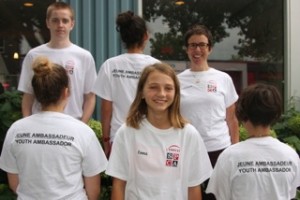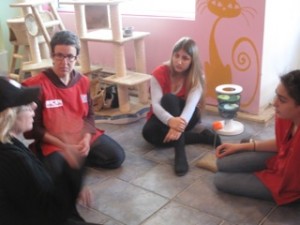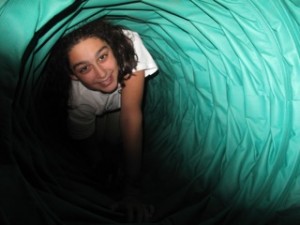The SPCA Annexe has recently developed an exciting and dynamic 10-month pilot project for teens, called the Youth Ambassador Program (YAP). It offers the opportunity for small groups of youths aged 12-17 to participate in a series of 6-week sessions and become actively involved with the Annexe through supervised interaction with designated animals and structured fundraising activities. The goal of this project is twofold: to teach youths empathy and compassion and to develop social responsibility and provide youths a greater sense of civic-mindedness. The fee is $75.00.
Colleen Ovenden over sees this program so let’s get the scoop from her!
Where do you live and who lives with you, animals and humans
I live in the Mile-End with my two daughters Emilie, age 16 and Mikayla, age 12. I also live with Ocean, my dog (from the Annexe) and Thirty, who we found literally on Highway 30 (with cars going over him at 100K an hour…but that’s another story. Great article in the Gazette many years ago: http://www.canada.com/montrealgazette/news/montreal/story.html?id=406fabda-f5be-4e2e-8289-ceb39a020259). Often we live with fosters (mostly groups of sick kittens, sometimes dogs) but right now we’ve only got the two.
Did you have pets when you were young?
Yes, I had (many) cats (not all at once), dogs (three – not all at once), a turtle named Herbert and a hamster named Ben.
What was your first experience with animals? Two stories: My very first experience (that I remember – I was around 3 years old): our cat Tigo (his name was really Tiger but I couldn’t pronounce it) had a litter and when the kittens were just days old, one went missing. My parents were frantic trying to find it. I had taken it and was carrying it around in my watering can (thankfully without water). Another story: I was around 7 years old and I would secretly spend my allowance on Puss ‘n Boots cat food (I know, I know, I’m dating myself) to feed the cats in the neighbourhood. I would wait until my parents were asleep and then sneak into the garage and open the garage door just wide enough so that cats could come in a night and eat. My parents couldn’t figure out why there were cats always swarming our house. The sad part of the story is how they found out: a cat made its way up into my grandmother’s engine and she started her car in the morning. I had to come clean.
How did you begin to volunteer at the Montreal SPCA and what are some of your duties?
I began as a foster family with the Foster Department at the main shelter. At one point, I took in two young dogs that were at the Annexe. From the moment I stepped into the Annexe, I became a full-fledged volunteer there. For the first year, I was hands-on animals. In other words, walking, feeding, cleaning, socializing. After a year or so, I started to do committee work. I’m very interested in long-term solutions to issues surrounding the crisis in animal welfare.
When did you start planning the Yapper’s program? What gave you the idea? What was involved in beginning the program?
The quick and boring background to this is that I had approached the SPCA a number of times over the past couple of years to do youth development/community outreach initiatives. I had also proposed to develop curriculum that would work jointly with the pedagogical objectives of the recently-implemented Ethics and Religious Culture (ERC) course that is mandatory in Québec schools from Grade 1 right through to Grade 11. My idea was develop an animal welfare component that fosters compassion and respect for all living beings, which is directly linked to “the recognition of others” and “the pursuit of the common good,” the two main objectives of the ERC program. Although this idea wasn’t developed, it’s still my conviction that an animal welfare component should be incorporated, as a vital component, into the ERC curriculum for Québec schools…. I’m currently on an Annexe Fifth Anniversary committee where we were discussing a series of projects for the coming celebratory year and thought that this might be a good time and place to discuss my idea. It (the idea) was met with great encouragement and enthusiasm. I then wrote a short proposal and sent it to (Executive Director) Nicholas Gilman who really liked it as well. I met with Nicholas and Annexe Supervisor Summer Geraghty soon after and the program was officially a “go.”
Who is this course aimed at? The course is aimed at youths from age 12-17.
You have completed the first session. What feed back can you provide?
The first session was completed Thursday and I think it’s been an amazing experience for all (myself included). Not only did my group get to walk, feed, clean, socialize both dogs and cats (I forgot to mention that one needs to be 18 years of age to volunteer), we got to discuss responsible pet ownership, the importance of spaying and neutering, animal neglect, animal cruelty, BSL, and a host of other topics. And the SPCA actually let us work with dogs from a recent puppy mill seizure. I definitely see already an increase in self-esteem with some of the participants. I think they’re gaining a sense of pride in their accomplishment in making a difference in the lives of animals and in their community. Our group fundraising project is that we are making and selling homemade dog and cat treats at the High 5! Event. Future of the pilot project: I am currently working on a $0 operating budget. I’ve applied for foundation grants and next week I begin working on corporate donations. Being funded will allow me to do the curriculum development work needed that will turn this project into a much-needed and long-lasting program. I hope to strategically partner with some organizations I’m interested in as well as schools in the area. Over and above teens who are already like-minded, I’d also like to reach high-risk youth as well as disenfranchised youth from the area surrounding the SPCA.
TPK
“In rescuing animals, I lost my mind, but found my soul.” ~anonymous
 Montreal Dog Blog Montreal's Online Dog Park
Montreal Dog Blog Montreal's Online Dog Park









